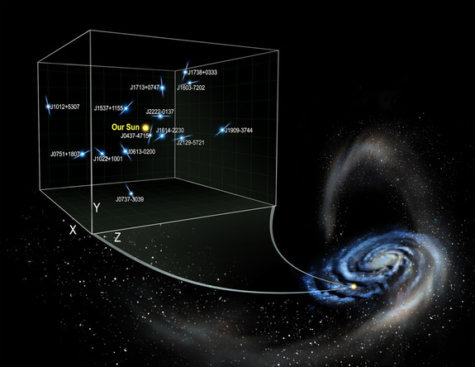PRINCETON, N.J. — For years scientists have studied the rapid expansion of the universe in hopes of revealing the dark energy behind it. It is known that stars have an acceleration because of their density combined with dark matter. In one recent study, researchers were able to directly measure the average acceleration occurring within the Milky Way.
Sukanya Chakrabarti of the Institute for Advanced Study guided scientists in the use of pulsar data to measure the accelerations, both radial and vertical, of stars in and around the galaxy. Because the amount of visible matter in the galaxy is known, the team was able to precisely calculate the density of the dark matter of the Milky Way galaxy.
“Our analysis not only gives us the first measurement of the tiny accelerations experienced by stars in the galaxy, but also opens up the possibility of extending this work to understand the nature of dark matter, and ultimately dark energy on larger scales,” says Chakrabarti, who is also the paper’s lead author, in a statement.
‘New window in galactic dynamics’
Although stellar acceleration can reach hundreds of kilometers per second, this study found that the change in the star’s velocities occurs at only a few centimeters per second, equivalent to a baby crawling. Similar to the ripples of water after throwing a rock, pulsars distributed in and around the galaxy were used to detect the slow change in velocities with high precision.
“By exploiting the unique properties of pulsars, we were able to measure very small accelerations in the galaxy. Our work opens a new window in galactic dynamics,” says co-author Philip Chang of the University of Wisconsin-Milwaukee.

The halo, which is the region surrounding the galaxy, is approximately 300,000 light-years from the center of the galaxy. Diffuse with stars, the halo makes up 90% of the mass of the galaxy and therefore, could help answer some questions about dark matter. Since the motion of stars within the halo can change due to dark matter, researchers have a better understanding of where and how to search for dark matter by the use of the measurements revealed by this study.
This study also reveals that the Milky Way galaxy is not in a state of equilibrium, but rather is constantly being disturbed by smaller galaxies outside of it, such as the Small and Large Magellanic Clouds. Because of this, stellar orbits are somewhat like a warped disk rather than flat. The use of NANOGrav (North American Nanohertz Observatory for Gravitational Waves), and pulsar data allowed the team to view the orbits directly.
“For centuries astronomers have measured the positions and speeds of stars, but these provide only a snapshot of the complex dynamical behavior of the Milky Way galaxy,” says Scott Tremaine, Professor Emeritus at the Institute for Advanced Study. “The accelerations measured by Chakrabarti and her collaborators are directly caused by the gravitational forces from the matter in the galaxy, both visible and dark, and thereby provide a new and promising window on the distribution and the composition of the matter in the galaxy and the universe.”
The study is published in Astrophysical Journal Letters.
